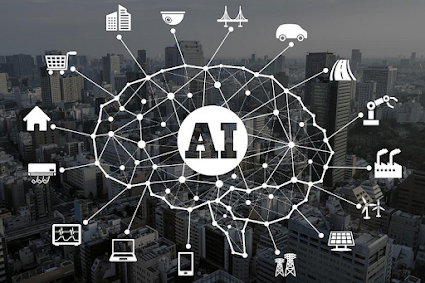Introduction to Artificial Intelligence
A Simple Explanation of AI and Its History
Artificial Intelligence (AI) is one of the most exciting and rapidly growing fields in technology. It has transformed industries, from healthcare to finance, and is shaping the future with advancements like self-driving cars and smart assistants. But what exactly is AI, and how did it all begin? Let's explore AI in simple words, covering its definition, history, and how it has evolved over time.
What is AI?
AI, or Artificial Intelligence, is the ability of computers or machines to think, learn, and make decisions like humans. Instead of just following fixed instructions, AI can analyze data, recognize patterns, and improve its performance over time.
Some common examples of AI in daily life include:
- Voice assistants like Alexa and Google Assistant
- Face recognition on smartphones
- Netflix and YouTube recommendations
- Chatbots that answer customer queries
- Self-driving cars
AI helps machines understand, predict, and automate many tasks, making life easier and industries more efficient.
The History of AI: How It Started and Evolved
Early Concepts (Before Computers Existed)
The idea of intelligent machines has been around for centuries. Ancient civilizations imagined mechanical beings with human-like intelligence.
- Greek mythology spoke about Talos, a giant bronze robot that protected Crete.
- 1206: An Islamic engineer named Al-Jazari designed early automated machines, which were simple but laid the foundation for future robotics.
- 1600s-1800s: Philosophers and mathematicians, like René Descartes and George Boole, explored ideas about logic and reasoning, which later influenced AI development.
At this point, AI was just an idea—there were no actual intelligent machines.
The Birth of AI (1950s-1960s)
The real journey of AI began when computers were invented. Scientists started exploring whether machines could "think" like humans.
- 1950: Alan Turing, a British mathematician, introduced the Turing Test, a way to check if a machine could imitate human intelligence.
- 1956: The term "Artificial Intelligence" was officially used for the first time at the Dartmouth Conference, marking the beginning of AI as a scientific field.
- 1950s-1960s: Early AI programs were created:
- Logic Theorist (the first AI program that solved mathematical problems).
- IBM’s Checkers AI (could play checkers against humans).
- ELIZA, the first chatbot, which could simulate basic conversations.
At this stage, scientists believed AI would soon match human intelligence, but they underestimated the challenges.
The First AI Boom (1960s-1970s)
AI research grew rapidly, and governments invested in AI projects.
- 1970: Shakey the Robot was introduced, one of the first AI-powered robots that could move, see, and respond to its environment.
- Expert systems were developed—AI programs that could make decisions like human experts in specific fields.
However, AI had limitations. Computers were slow, and AI models required a lot of data and processing power, which were not available at the time.
The AI Winters (1970s-1990s): Slow Progress and Setbacks
As AI struggled with real-world problems, funding for AI research was reduced. This period is known as the "AI Winter," when interest in AI faded due to:
- Lack of computing power to process AI models.
- AI systems failing in real-world situations.
- Overhyped expectations that did not match reality.
During the 1980s, expert systems became popular, helping businesses make decisions. However, they were expensive and difficult to maintain, leading to another decline in AI funding.
The AI Comeback (1990s-2000s)
With advancements in computing and the rise of the internet, AI research started making progress again.
- 1997: IBM’s Deep Blue defeated world chess champion Garry Kasparov, proving that AI could outperform humans in complex tasks.
- 2000s: The internet produced vast amounts of data, which helped AI models improve.
- Machine Learning became a major focus, where AI could learn from data rather than relying only on fixed rules.
AI was becoming more practical, but it still had limitations.
The AI Revolution (2010s-Present)
In the last decade, AI has made huge breakthroughs, becoming part of everyday life.
- 2011: IBM Watson defeated humans in Jeopardy, showcasing AI’s ability to process and understand natural language.
- 2012: Deep learning, a more advanced AI technique, helped AI recognize images and speech better than ever before.
- 2016: Google’s AlphaGo defeated a human champion in the complex board game Go, proving that AI could master strategic thinking.
- 2020s: AI-powered tools like ChatGPT, DALL·E, and AI assistants have changed the way we interact with technology.
AI is now widely used in healthcare, finance, cybersecurity, education, and creative fields, shaping the future in ways never imagined before.
The Future of AI: What’s Next?
AI is constantly evolving, with researchers working toward more advanced and ethical AI systems. The key areas of future AI development include:
- General AI: Machines that can think, learn, and reason like humans.
- AI in Healthcare: AI-powered diagnosis, robotic surgeries, and drug discovery.
- Self-Driving Vehicles: AI will play a bigger role in transportation.
- AI in Scientific Research: AI is being used for space exploration, climate change solutions, and advanced robotics.
While AI is growing rapidly, ethical concerns remain. Developers are working to ensure AI is fair, unbiased, and used responsibly.
Conclusion
AI has come a long way from being just an idea in ancient times to a powerful tool shaping our daily lives. While we are still far from creating machines with true human intelligence, AI has already made a significant impact. The journey of AI is ongoing, and its future holds endless possibilities.
Artificial Intelligence is no longer just science fiction—it is a reality shaping the world, and it is here to stay.
.jpg)

.png)
Comments
Post a Comment